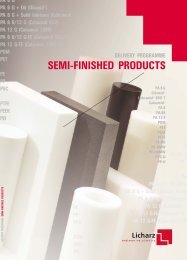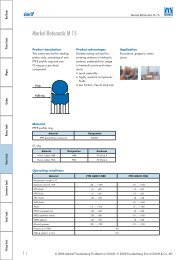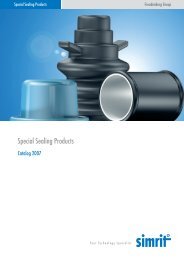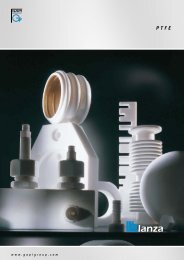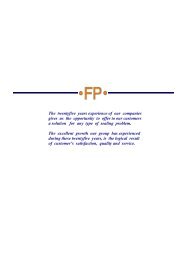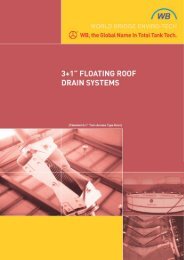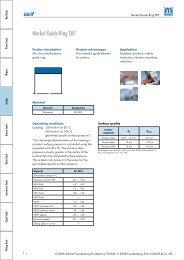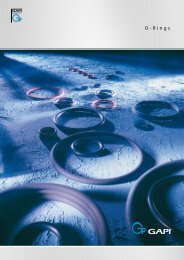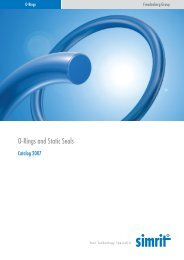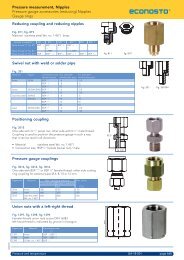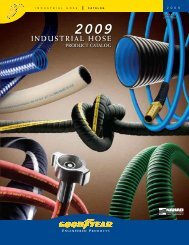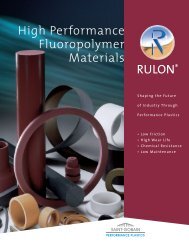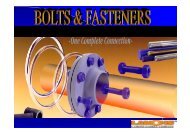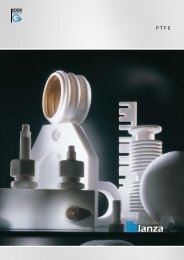Oleodinamica/Pneumatica Hydraulic/ Pneumatic
Oleodinamica/Pneumatica Hydraulic/ Pneumatic
Oleodinamica/Pneumatica Hydraulic/ Pneumatic
Create successful ePaper yourself
Turn your PDF publications into a flip-book with our unique Google optimized e-Paper software.
con le guarnizioni di tenuta.<br />
Sono stati effettuati parecchi test, soprattutto con oli<br />
ecologici, che hanno sempre dato esito positivo.<br />
Quando però manca questa sicurezza, per esempio<br />
nel caso di un lubrificante poco noto o comunque<br />
mai testato, ARTIC SEALS si rende disponibile a<br />
verificare la compatibilità nel proprio laboratorio.<br />
In caso di fluidi diversi da quelli tradizionali o<br />
comunque addizionati con sostanze particolari si<br />
pone il problema della resistenza chimica delle<br />
guarnizioni.<br />
La tabella che segue vuole fornire indicazioni in tal<br />
senso e si riferisce specificatamente ai materiali<br />
utilizzati da ARTIC SEALS.<br />
Materiali<br />
Gli elementi di un sistema di tenuta sono molteplici<br />
ed ognuno deve avere caratteristiche che gli<br />
permettano di svolgere la propria funzione nel<br />
migliore dei modi ed in condizioni non sempre simili.<br />
La scelta dei materiali assume così un’importanza<br />
tale da farne il primo fattore strategico per ogni<br />
costruttore.<br />
ARTIC SEALS, forte della propria esperienza, ha<br />
scelto:<br />
- resine uretaniche in cinque differenti tipologie.<br />
Presentano tutte alto modulo elastico e bassa<br />
deformazione permanente e con durezze diverse a<br />
seconda dell’utilizzo.<br />
Con esse vengono realizzate guarnizioni di tenuta<br />
per stelo e pistone, anelli raschiatori ed alcuni tipi<br />
di tenuta statica;<br />
- resine acetaliche di due differenti tipologie.<br />
La prima caricata con fibre di vetro ed elevata<br />
resistenza alla deformazione permanente sotto<br />
carico, utilizzata in oleodinamica. La seconda,<br />
priva di cariche, ma additivata con sostanze<br />
autolubrificanti, impiegata in pneumatica quando<br />
direttamente a contatto con metalli teneri come<br />
l’alluminio e l’ottone. Con esse vengono realizzati<br />
oils, and the outcome was always positive.<br />
In case of uncertainty, for example when the<br />
lubricant is not very well known, or has never been<br />
tested before, ARTIC SEALS is ready to assess its<br />
compatibility in its laboratories.<br />
In the event of non-traditional fluids or of particular<br />
additives, the chemical resistance of the seals comes<br />
into question.<br />
The following table is meant to provide useful insight<br />
into these occu rences. It refers in particular to the<br />
materials used by ARTIC SEALS.<br />
Materials<br />
A sealing system is composed of many parts and<br />
the features of each of them must enable the best<br />
performance in conditions which often vary.<br />
The choice of materials is therefore important<br />
enough to make it the primary strategic factor for<br />
all manufacturers. ARTIC SEALS, on the basis of its<br />
experience, has chosen the following materials:<br />
- five types of urethane resins. They have a high<br />
modulus of elasticity, low compression-set and the<br />
hardness used varies according to the application.<br />
They are used for producing rod and piston seals,<br />
scraper rings and some static seals;<br />
- two types of acetalic resins. The first one, used for<br />
hydraulic applications, is filled with fibreglass and<br />
has low compression-set. The second one is not<br />
filled but has self-lubricating additives. It is used<br />
in pneumatic systems where there is direct contact<br />
with soft metals like aluminium or brass. They are<br />
used in the manufacture of rods and pistons wiper<br />
rings or other components which function like<br />
<strong>Hydraulic</strong>/ <strong>Pneumatic</strong> 9<br />
Sezione tecnica<br />
Technical overview



